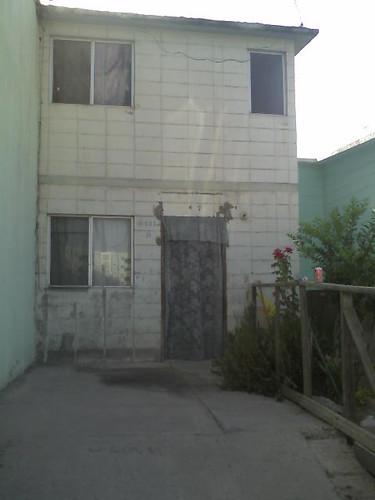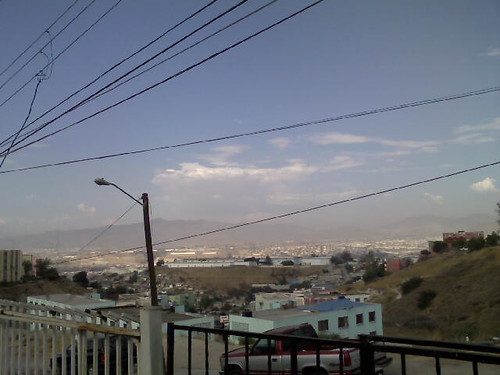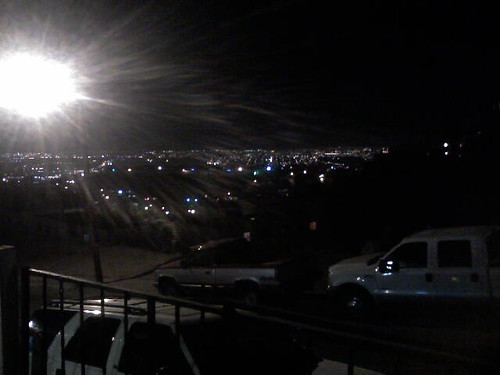Nieve
The entryway into this cul d’ sac, the street consisting of carefully placed stones, creates an echo and magnifies any sound that bounces off of the cinderblock and cement, so that all of the daily residential business becomes heard no matter what. There is a tamale vendor that comes twice every day, once in the morning and once in the evening, driving a small car with a speaker mounted on the top. Slowly, the car rolls in and turns around, finally exiting from where it came.
"Tamales ricos, de elote, de carne, de chile verde!"
The voice is pre-recorded, a pleasant sounding young woman, announcing the offerings over and over again on a forever-looping cassette tape.
Throughout the morning and into the afternoon, no fewer than four propane trucks roll in, honking over and over again, the propane tanks rattling around as the vehicle bounces over the unevenness of the terrain. A tank of propane costs four hundred and twenty five pesos and will cost even more in no time at all. For fewer than fifty dollars, I have gas for a month, so every thirty days or so I step out of the door and flag a truck down.
Like most of the small houses in and around Tijuana, there is no outside access to the back of the house where the tanks are stored. I have a hand truck, the propane vendor uses that to get the new tank in and take the old tank out, so that the alternative method of rolling the tank at an angle won’t crack the ceramic tile in the house. He gives me a receipt, for no apparent reason. I keep the receipts, in case someone comes along and asks me for them.
It has been over sixteen years, and no one ever has.
Whenever I visit someone in the United States of America, the relative lack of noise in the suburban neighborhoods there always amazes me. I have become accustomed to the noisy affairs of life down here, where only in the dead of night is it truly quiet. For over a decade of my time here, I lived up the hill from where I live now, sometimes I still miss it. I went back up the hill the other day, Rocio’s parents have lived there for over twenty years, and I went to see the old neighborhood.

Where we used to live a couple of houses down, the new residents have built a little store in front of the house. This is common in Tijuana and throughout Mexico, that in the sprawl of the larger cities, the convenience of a small shop a few yards away can generate money from neighbors that don’t mind spending a couple of pesos more to spare the longer walk or a taxi ride down the hill. City zoning is relaxed, and no one really minds. Besides, where is someone supposed to build a supermarket in the densely populated hillsides of Tijuana?
Infonavit Latinos isn’t unlike most of the government-built neighborhoods in Tijuana, designed to provide affordable housing to the working class. Condominiums are five stories high, while houses are either one or two stories, built compactly and snuggled next to each other in order to maximize space. Cinderblock is the building material of choice, and the roofs are made out of cement. This has the opposite effect that would be desirable in the climate of Northern Baja, it makes the inside of the dwelling extremely cold in the wintertime due to the lack of insulation, and hot as an oven in summer due to the heat-conductive qualities of the cement.
Still, no one complains much.

These dwelling are well constructed in some ways and poorly constructed in others – the basic structure is sound, but the details are shoddy and often times fail quickly. The contract to build a section of an infonavit is awarded to some engineering firm, and once that the basic designs are approved, the engineering company then subcontracts the construction to a low bidder. Many times, the low bidder will subcontract, and then the subcontractor will subcontract, and by the time the actual builders are awarded the deal, in order to make money corners are cut wherever possible. The wiring is often faulty and the electrical receptacles are cheap and there is only one per room; doors and windows are wracked and fail over time; and to save time and money, the waterlines actually run underneath the foundation which makes repair extremely difficult.
In a country where many still live without running water or electricity, even with their faults these houses and condominiums are more than adequate. And the progress over sixteen years has been quite remarkable. It used to be rare to find anyone with a telephone line and the entire system was analog, and inefficient. Now it is rare to know someone without a landline, much less cellular access. Six years ago, dial-up internet was a luxury, and now asymmetric digital subscriber lines are available everywhere except for the most remote areas of Baja.

Soon, housing tracts will be constructed with underground electrical and telephone lines. And while the infrastructure of the existing parts of Baja make it difficult to overcome the fact that, basically, the cities were never built to hold a population of their size, new additions are becoming modernized in terms of planning. Sewer systems are better, roads are more easily navigated, and freeways are being built in order to carry the explosion of vehicle-owning residents.
Baja will continue to become modernized, because it has to.
Every day at around lunchtime, here in this cul d’ sac the same sound can be heard.
"Nieveeeeees!"
And waiting a few moments, just to listen and try and figure out whether what one just heard was real or imagined, the next thing that one would hear after a few moments:
"Nieve-nieveeeeees!"
The old man pushes his ice-cream cart into the bumpy stones, slowly and hopefully, like so many vendors that roam the Tijuana streets trying to make a living. Nieve means snow in Spanish, technically, but the man is selling ice cream and snow cones. Often, people go door to door and sell cheese, too, made at nearby ranches where sometimes an overabundance of dairy products are offered at a good price.
Sometimes, when I walk a couple of blocks to the store, I pass several other sellers that have set-up shop on a street corner. Elote is corn, the carts contain steamers and you can get some steamed corn on the cob, or the more popular way which is cut off of the cob into a disposable cup with butter and picante sauce and dry cotija cheese and a plastic spoon so you can eat it right there on the street.
There are always taco stands and hot dog carts and regardless of how many fast food franchises that appear in Baja, this gringo will always embrace whatever part of this place that can’t be ruined by its necessary progress. It isn’t about putting up with the sounds and noise of the neighborhood and the street vendors and so on, it’s about finding beauty in it, serenity from it, and meaning out of it.

So many years ago, when I first came to this place, before I learned Spanish and anything about Mexico, I would look out toward the Eastern Tijuana valley and wonder about all of the twinkling lights, contemplating the lives of everyone down there. I am part of it now, and it hit me the other evening about how maybe someone else is up there at night looking down on the twinkling lights, thinking about the people that live down below. Someone else is probably up there listening to similar sounds that I hear every day, looking out at night and wondering if we hear the same things down below.
We do, amigo. We do.


1 Comments:
Last night I was walking down Calle Novena in Colonia Libertad, from parte media to parte baja, and I noticed all the twinkling lights. You can see street lamps and house lights dancing in the darkness all the way from the western border to Cerro Colorado. Federico Campbell never had it so good.
I would mention, however, that cinderblock passed into dissuetude sometime in the 1920s or '30s. What we use nowadays is called locally "bloque" and "CMU" by the gringos, that is to say, "cement masonary units". It is not the best building material for a desert climate but the construction technique is prehispanic and the family that owns the cement monopoly in Mexico is incredibly powerful.
I shall be joining you soon in the blogosphere, don Refrito. Request for a reciprocal link to follow.
Post a Comment
Subscribe to Post Comments [Atom]
<< Home